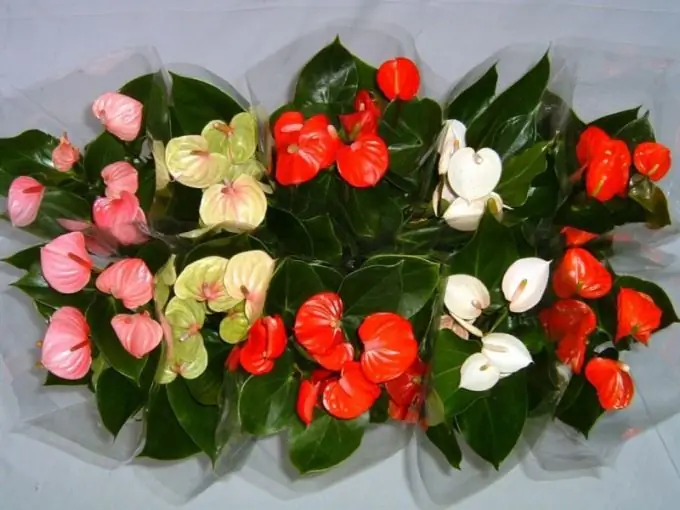Anthurium is a luxurious houseplant with weighty shiny leaves and beautiful flowers: you just can't take your eyes off it. But, unfortunately, flower growers often face problems when growing this indoor plant, for example, its leaves turn black and dry.

Why do the leaves of a houseplant dry and how to deal with it
The main reasons why anthurium leaves dry up include the following:
- insufficient watering;
- too dry air;
- defeat by greenhouse aphids;
- anthracnose, etc.
As a rule, with poor watering and insufficient moisture level, leaf plates wither and dry very quickly. The intensity of watering should depend on the time of year: in the summer, the anthurium should be watered abundantly, and in the winter, watering should be reduced. The basic rule: between watering, the substrate in the pot should dry out by 1 / 3-1 / 2 of the flowerpot. At the same time, the ideal indicator of air humidity when growing this indoor plant is 85-95%. If you create these conditions, the leaves of the plant will not dry out.
If the anthurium does not bloom, the reason lies in insufficient lighting and improper feeding.
With anthracnose, the leaf plate begins to dry from the edges, then the leaf becomes thinner, and then it dries completely. Treatment of an affected houseplant is to treat its leaves with a systemic fungicide.
In case of damage to a houseplant by a greenhouse aphid, the leaves of anthurium wrinkle, curl and become covered with light spots (this process is accompanied by the fall of flowers). To get rid of the pest, the affected plant is treated with Karbofos and Actellik.
Blackening of anthurium leaves and the fight against this phenomenon
Reasons for blackening of leaf plates:
- direct sunlight;
- draft;
- inappropriate temperature conditions;
- the predominance of calcium salts in the substrate.
Anthurium does not tolerate drafts well: its leaves curl and turn black. Therefore, this houseplant needs to be moved to another, safe place for it.
Watering with hard and cold water can provoke the appearance of brown spots on the leaf plates of anthurium.
Anthurium leaves turn black from direct sunlight, which is why this houseplant must be shaded. Ideally, this should be diffused sunlight or partial shade.
Too high or low temperature is the reason for the appearance of black spots on the leaf plates of the plant. Indoors in summer, the temperature should vary from 25 to 28 ° C, and in winter - 17-19 ° C.
The presence of calcium salts in the soil is evidenced by limescale on the inside of the flowerpot. In this case, it is recommended to change the substrate (if it is completely impossible to replace the soil, at least to replace the upper soil layer), enriching it with leaf humus or peat. In the future, the houseplant must be watered with exceptionally soft water.






